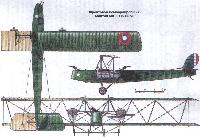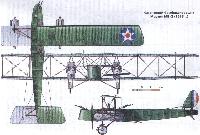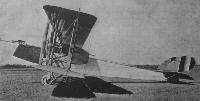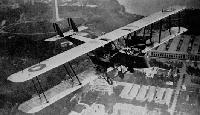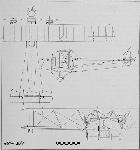А.Шепс Самолеты Первой мировой войны. Страны Антанты
Этому самолету также не суждено было принять участие в боевых действиях, но именно он стал основой бомбардировочной авиации американской армии в начале 1920-х годов. Командование USAAS (US. Army Air Service - Авиационной службы армии США) заказало фирме "Глен. Л. Мартин" бомбардировщик с параметрами, соответствующими британскому самолету Хендли Пейдж 0/400. 17 августа 1918 года самолет совершил свой первый вылет. В USAAS он получил название GMB "Глен Мартин Бомбер" или MB-1.
Это был трехстоечный биплан цельнодеревянной конструкции. Фюзеляж прямоугольного сечения в носовой части обшивался фанерным листом, а в хвостовой части - полотном. В носу самолета и в середине фюзеляжа за задней кромкой крыла устанавливались турели со спарками 7,62-мм пулеметов "Льюис". Кабина пилотов располагалась перед крылом. Крыло двухлонжеронное, цельнодеревянной конструкции, обтянутое полотном. Стойки крыла - стальные трубы в деревянных обтекателях. Оперение обычного типа. Стабилизатор устанавливался на верхней поверхности фюзеляжа. Вертикальное оперение двухкилевое. Управление рулями и элеронами тросовое, от штурвала. Шасси имело четыре V-образные главные стойки, соединенных горизонтальными раскосами, установлено четыре колеса. Амортизация резиновая шнуровая. Два двигателя 12-цилиндровых, жидкостного охлаждения, рядных, V-образных.
"Либерти" 12-A по 400 л. с. устанавливались на стойках над нижним крылом и крепились дополнительными раскосами к фюзеляжу. Радиаторы лобовые сотовые, монтировались перед двигателем на общей раме.
Первые 4 машины выпущены были в варианте разведчика, без бомбового вооружения. Восьмой самолет специально был изготовлен для дальнего перелета на 2400 км и назывался GMT (трансконтинентал). Девятый самолет был вооружен 37-мм пушкой на носовой установке, а самолет назывался GMC (С -- Cannon). В 1919 году был выпущен шестиместный пассажирский самолет с закрытой остекленной пассажирской кабиной, который в 1920-1923 годах строился небольшой серией. В 1920 году для U.S. Navy были построены два торпедоносца, получившие обозначение МВТ.
Дальнейшим развитием MB-1 стал ночной бомбардировщик MB-2. Новая машина обладала существенными отличиями. Крыло имело большой размах и большую площадь. Вместо трех пар наклонных стоек бипланной коробки устанавливались четыре пары вертикальных стоек. Изменилась конструкция крепления более мощных двигателей. Вместо лобовых радиаторов установили сотовые над двигателем. Шасси пирамидальное, с колесами большого диаметра. Увеличен объем топливных баков для повышения дальности полетов. Самолет был запущен в серию под обозначением NBSR-1 (Night Bomber Short Range - ночной ближний бомбардировщик). 15 машин построила фирма "Мартин", еще 35 - фирма "Лоу, Виллард, Фулер" (LWF), 50 самолетов выпустила фирма "Кертисс" и 25 - "Аэромарин". Четыре машины фирмы LWF были построены в варианте учебного самолета, с двойным управлением. Эти самолеты находились на вооружении до конца 1920-х годов, когда стали заменяться бомбардировщиками фирмы "Хейстон".
Показатель MB-1 MB-2
Размеры, м:
длина 13,66 13,00
размах крыльев 21,77 22,60
высота 4,45 4,47
Площадь крыла, м2 99,4 104,1
Вес, кг:
максимальный взлетный 4640 5470
пустого 3040 3300
Двигатель: "Либерти" 12-A "Либерти" 12-B
число х мощность, л.с. 2x400 2x420
Скорость, км/ч 170 160
Дальность полета, км 630 900
Потолок практический, м 3140 2600
Экипаж, чел. 3 4
Вооружение 3-4 пулемета 3-4 пулемета
470 кг бомб 815-1360 кг бомб
Показать полностью
G.Swanborough, P.Bowers United States Military Aircraft Since 1909 (Putnam)
Martin MB-1/T-1
Following his withdrawal from the Wright-Martin combine of 1916, Glenn Martin re-established his own company in Cleveland, Ohio, late in 1917. During conferences held in Washington to unsnarl the World War I aircraft procurement mess, Martin was asked to design a new bomber that would outperform the British Handley-Page. An order for ten MB-1s was signed and the first one flew on August 17, 1918.
Powered with two Liberty engines, the MB-1 (also known as the GMB for Glenn Martin Bomber, to distinguish it from the contemporary J. V. Martin bomber), was more than just a bomber although it followed the established European four-five seat configuration. High power and relatively small size made the MB-1 a multi-purpose design. It was also intended to be a long range observation and photographic machine and its 120 m.p.h. top speed combined with three gun stations gave it escort fighter capability.
The first four MB-1s were built as observation types and the next three were bombers. The eighth was a special long distance version with 1,500-mile range while the ninth was a bomber fitted with a 37-mm. cannon on the nose.
The last aeroplane on the original MB-1 contract was completed in 1919 as a transport by removing the military equipment, raising the top of the fuselage to provide headroom, and adding cabin windows and seats for ten passengers. The open pilot’s cockpit was also converted to a glassed-in enclosure. This version was originally known as GMP for Glenn Martin Passenger, but was redesignated T-1 in the short-lived T-for-Transport series of 1920/23. It was followed by another conversion, the last article in a later four-plane MB-1 contract. Six modified MB-1s were built for the Government Postal Service and two MB-1s were built for the Navy as part of a 10-plane torpedo bomber order.
TECHNICAL DATA (MB-1)
MANUFACTURER: Glenn L. Martin Co., Cleveland, Ohio.
TYPE: Army support reconnaissance and bomber.
ACCOMMODATION: Crew of three.
POWER PLANT: Two 400 h.p. Liberty 12A piston Vee in-line.
DIMENSIONS: Span, 71 ft. 5 in. Length, 44 ft. 10 in. Height, 14 ft. 7 in. Wing area, 1,070 sq. ft.
WEIGHTS: Empty, 6,702 lb. Gross, 10,225 lb.
PERFORMANCE: Max. speed, 105 m.p.h. at sea level. Cruising speed, 92 m.p.h. at sea level. Initial climb, 630 ft./min. Service ceiling, 10,300 ft. Range, 390 st. miles.
ARMAMENT: Five 0-30-in. machine guns in nose and amidships. 1,040-lb. bombs.
SERIAL NUMBERS: 39055/39064; 62948/62951.
�
Martin MB-2/NBS-1
The MB-2 was a direct development of the MB-1 of 1918, and used essentially the same wooden fuselage and tail unit fitted with larger wings and revised power plant and landing gear installations. The non-staggered wings were hinged at the rear spars just outboard of the engines and folded aft in the manner of the British Handley-Page O-400. Except for later naval designs, the MB-2 was the only large U.S.-designed aeroplane to use this feature. The MB-2 was designed specifically as a night bomber, sacrificing the flashing speed and manoeuvrability of the MB-1, which were not considered essential for a night bomber, to greater bomb load.
Twenty MB-2s were ordered from Martin in 1920, five under the original factory designation (64194/64198) and 15 as NBS-1 (64199/ 64213) in the category for Night Bomber, Short Range under the new Army designating system. Under the prevailing Army policy of dividing the meagre procurements of the time among the hard-pressed manufacturers, additional orders for NBS-1s were placed with other firms. Lowe, Willard, and Fowler (L.W.F.) got an order for 35 (68437/68471) and Curtiss received an order for 50 (68478/68527). Upon completion, the first L.W.F. NBS-1 was sent to Aeromarine as the pilot model for a new 25-plane order (22-201/225) and the remainder were shipped overseas. The last 20 NBS-1s on the Curtiss order were fitted with turbo-superchargers.
The bomb load varied from 1,800 lb. to a maximum of 3,000 lb., with internal stowage in the fuselage for all but the largest bombs. Defensive armament was a pair of 0-30-inch calibre Lewis guns on Scarff rings around the nose and aft cockpits and a single Lewis firing downward from the bottom of the fuselage. Never used in war, the MB-2/NBS-1’s major claim to fame is the sinking of the ex-German battleship Ostfriesland in the controversial Billy Mitchell bombing exercises of July 1921. The NBS-1s, the only production bombers ever specifically designated as night bombers by the U.S. Army, remained in service until replaced by Keystone LB-5s and 6s in 1927/28.�
TECHNICAL DATA (NBS-1)
MANUFACTURER: Glenn L. Martin Co., Cleveland, Ohio.
TYPE: Short distance night bomber.
ACCOMMODATION: Crew of four.
POWER PLANT: Two 420 h.p. Liberty 12 piston Vee in-line.
DIMENSIONS: Span, 74 ft. 2 in. Length, 42 ft. 8 in. Height, 14 ft. 8 in. Wing area, 1,121 sq. ft.
WEIGHTS: Empty, 7,269 lb. Gross, 12,064 lb.
PERFORMANCE: Max. speed, 99 m.p.h. at sea level. Cruising speed, 91 m.p.h. Initial climb, 391 ft./min. Service ceiling, 8,500 ft. Range, 558 st. miles.
ARMAMENT: Five 0-30-in. guns in nose and amidships.
SERIAL NUMBERS:
MB-2: 64194/64198.
NBS-1: 68437/68471 (by LWF); 68478/68527 (by Curtiss); 22-201/225 (by Aeromarine); 64199/64213 (by Martin).
Показать полностью
G.Swanborough, P.Bowers United States Navy Aircraft Since 1911 (Putnam)
MARTIN MBT/MT
The Martin MB-1 was a revolutionary bomber built for the Army in 1918. The Navy bought two duplicates in 1920 as MBT (A5711-A5712) for Martin Bomber-Torpedo. Eight improved versions (A5713-A5720) were designated MT for Martin Torpedo. Used by the US Marines, the MTs were MB-1s with the longer wings of the Army MB-2. MT data: power plant, two 400 hp Liberty. Span, 71 ft 5 in; length, 45 ft 8 in; gross weight, 12,098Ib; max speed, 109 mph.
Показать полностью
Jane's All The World Aircraft 1919
THE MARTIN TWIN-ENGINED BOMBER.
The Martin twin-engined bomber constitutes one of the most important developments in bombing airplanes of original American design. In its official test, at Wilbur Wright Field, the all-round performance of this machine, considering the load carried, has easily excelled any other record from a similar bomber, either hero or abroad. The machine shows excellent workmanship and such thoroughness of engineering that the organisation is to be complimented upon the talent of their personnel. Mr. Martin is proud of the ability of his assistants, Mr. Lawrence D. Bell, factory manager; Mr. Eric Springer, pilot; and Mr. Donald W. Douglas, aeronautical engineer; and he prophesies important futures in their respective specialties. Lawrence D. Bell, has been with Mr. Martin for seven years, and is noted for his production management. Eric Springer learned to fly at the Martin School five years ago. He is an unusually capable tester and flyer, having made an enviable record in five years of piloting for the Martin Company without an accident. Donald W. Douglas came from the Boston Tech., joining the Martin plant in Los Angeles four yews ago, and in that abort length of time has grown to bo recognised as one of the foremost aeronautical engineers.
The all-round efficiency of the Martin bomber has been proven in its official performance trials. An official high speed at the ground of 118.5 m.p.h was made on the first trials, with full bombing load on board. This speed has been bettered since, due to the better propeller efficiency arrived at by expensive experiments. With full bomb load, the climbing time to 10,000 feet was 15 minutes, and a service ceiling of between 16,000 and 17,000 feet was attained.
General Description.
As a military machine, the Martin " Twin " is built to fulfil the requirements of the four following classes:-(1) Night bomber, (2) day bomber, (3) long-distance photography, (4) gun machine.
(1) As a night bomber it is armed with three flexible Lewis machine guns, one mounted on the front turret, one on the rear, below and to the sides, under the concave lower surface of the body. It carries 1,500 lbs. of bombs and 1,000 rounds of ammunition, A radio-telephone set and the necessary instruments are curried on all four types. The fuel capacity in all four types is sufficient for four and a half hours' full power at the ground and six hours' full power at 15,000 feet. This gives the machine gasoline for the climb to 15.000 feet, and enough more for about six hundred miles.
(2) As a day bomber two more Lewis guns are carried, one more on each turret. The bomb capacity is cut to 1,000 lbs. to give the higher ceiling necessary for day work.
(3) When equipped as a photography machine, the same number of guns as in the case of the day bomber are carried: but in place of the bombs two cameras are mounted in the rear gunner's cockpit. One camera is a short focal length semiautomatic, and the other is a long focal length hand-operated type.
(4) The gun machine is equipped for the purpose of breaking up enemy formations In addition to the five machine guns and their ammunition as carried on the photographic machine, a semi-flexible 37 mm. cannon is mounted in the front gun cockpit, firing forward, and with a fairly wide range in elevation and azimuth. This cannon fires either shell or shot, and is a formidable weapon.
The Martin "Twin" is easily adaptable to the commercial uses that are now practical They are:-(1) Hall and express carrying, (2) transportation of passengers. (3) aerial map and survey work.
(1) As a mail or express machine a ton may bo carried with comfort, not only because of the ability of the machine to efficiently handle this load, but because generous bulk stowage room is available.
(2) Twelve passengers, in addition to the pilot and mechanic, can be carried for non-stop runs up to six hundred miles.
(3) The photographic machine, as developed for war purposes, is at once adaptable to the aerial mapping of what will become the main flying routes throughout the country. The accuracy that is being obtained in aerial photography should be of vast value in survey and topographical map work. The Martin airplane, with its great cruising radius and complete camera installation, presents itself as the logical machine in this field.
General Dimensions and Data.
1. Power Plant.
Two 12-cyl. Liberty engines.
2. Wing and Control Surface Areas.
Main planes, total 1,070 sq. ft.
Upper planes, including ailerons 550 sq. ft.
Lower planes, including ailerons 620 sq. ft.
Ailerons, each 32,5 sq. ft.
No. of ailerons 4
Vertical fins. each 8.8 sq. ft.
No. of fins 2
Stabilizer 62.25 sq ft.
Elevator 43.20 sq.ft.
Rudders, each 16.50 sq.ft.
No. of rudders 2
3. Overall Dimensions.
Span, upper and lower 71 ft. 5 in.
Chord, upper and lower 7 ft. 10 in.
Gap 8 ft. 6 in.
Length overall 46 ft.
Height overall 14 ft. 7 in.
Incidence of wings with propeller axis 2 degrees.
Dihedral None.
Sweep back None.
Decalage, wings None.
Stabilizer, setting with wing chord +1 degree,
adjustable between -5 degress,
normal setting -2 degrees.
Показать полностью


